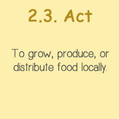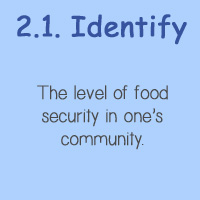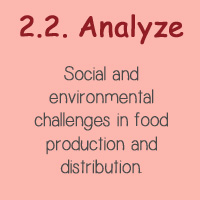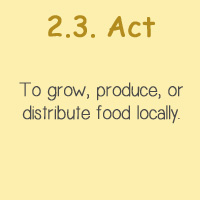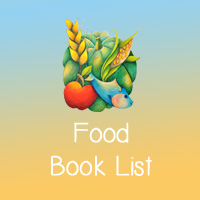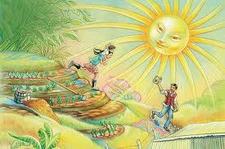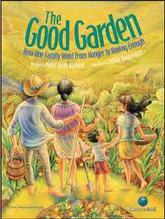Classroom Learning Activities
|
1. Food Safe Communities
|
|
|
2. People Study
|
Maria Cecilia Vasquez (the Real Maria Luz)
Eleven year old María Luz and her family live on a small farm. This year their crop is poor, and they may not have enough to eat or to sell for other essentials, such as health care, school uniforms and books. When María's father must leave home to find work, she is left in charge of their garden. Then a new teacher comes to María's school and introduces her to sustainable farming practices that yield good crops. As María begins to use the same methods at home, she too sees improvements that allow her family to edge their way out of the grip of the greedy "coyotes" — the middlemen who make profits on the backs of poor farmers. Little by little, the farms — and the hopes — of María Luz and her neighbours are transformed as good gardens begin to grow. Today Maria Cecelia Vasquez (the real Maria Luz) is a community facilitator in Honduras helping over 300 families apply for small loans and providing advice and support to them as they work themselves out of poverty. How to use this book in your classroom or library: Go here for full resource and visit The Good Garden website. Activities and Discussions include:
|
Maria Cecilia Vasquez (the Real Maria Luz)
The true story about Maria Cecilia Vasquez that inspired the book, The Good Garden by Katie Smith Milway
|
|
3. The Power of Community: How Cuba Survived Peak Oil
When the Soviet Union collapsed in 1990, Cuba's economy went into a tailspin. With imports of oil cut by more than half – and food by 80 percent – people were desperate. This film tells of the hardships and struggles as well as the community and creativity of the Cuban people during this difficult time. Cubans share how they transitioned from a highly mechanized, industrial agricultural system to one using organic methods of farming and local, urban gardens. It is an unusual look into the Cuban culture during this economic crisis, which they call "The Special Period." The film opens with a short history of Peak Oil, a term for the time in our history when world oil production will reach its all-time peak and begin to decline forever. Cuba, the only country that has faced such a crisis – the massive reduction of fossil fuels – is an example of options and hope. View this movie about a community's remarkable effort to become food secure by cooperating to problem solve and find innovative solutions to a national threat to their food security. Answer the following questions while viewing:
|
See how a community problem-solved to find solutions to a crisis through cooperation, conservation, and curtailment. The Power of Community:
How Cuba Survived Peak Oil is a project of the Arthur Morgan Institute for Community Solutions, a non-profit organization that designs and teaches low-energy solutions to the current unsustainable, fossil fuel based, industrialized, and centralized way of living. See more at The Power of Community. |
"The lack of fuel caused us to have a big shortage of food so people ended up finding places in the city to grow food; a drastic effort to convert every piece of arable land into agriculture had begun." (The Power of Community: How Cuba Survived Peak Oil)
Relevant Convention Articles
Article 6
1. States Parties recognize that every child has the inherent right to life.
2. States Parties shall ensure to the maximum extent possible the survival and development of the child.
Article 24
1. States Parties recognize the right of the child to the enjoyment of the highest attainable standard of health and to facilities for the treatment of illness and rehabilitation of health. States Parties shall strive to ensure that no child is deprived of his or her right of access to such health care services.
2. States Parties shall pursue full implementation of this right and, in particular, shall take appropriate measures:
(a) To diminish infant and child mortality;
(b) To ensure the provision of necessary medical assistance and health care to all children with emphasis on the development of primary health care;
(c) To combat disease and malnutrition, including within the framework of primary health care, through, inter alia, the application of readily available technology and through the provision of adequate nutritious foods and clean drinking-water, taking into consideration the dangers and risks of environmental pollution;
(d) To ensure appropriate pre-natal and post-natal health care for mothers;
(e) To ensure that all segments of society, in particular parents and children, are informed, have access to education and are supported in the use of basic knowledge of child health and nutrition, the advantages of breastfeeding, hygiene and environmental sanitation and the prevention of accidents;
(f) To develop preventive health care, guidance for parents and family planning education and services.
3. States Parties shall take all effective and appropriate measures with a view to abolishing traditional practices prejudicial to the health of children.
4. States Parties undertake to promote and encourage international co-operation with a view to achieving progressively the full realization of the right recognized in the present article. In this regard, particular account shall be taken of the needs of developing countries.
1. States Parties recognize that every child has the inherent right to life.
2. States Parties shall ensure to the maximum extent possible the survival and development of the child.
Article 24
1. States Parties recognize the right of the child to the enjoyment of the highest attainable standard of health and to facilities for the treatment of illness and rehabilitation of health. States Parties shall strive to ensure that no child is deprived of his or her right of access to such health care services.
2. States Parties shall pursue full implementation of this right and, in particular, shall take appropriate measures:
(a) To diminish infant and child mortality;
(b) To ensure the provision of necessary medical assistance and health care to all children with emphasis on the development of primary health care;
(c) To combat disease and malnutrition, including within the framework of primary health care, through, inter alia, the application of readily available technology and through the provision of adequate nutritious foods and clean drinking-water, taking into consideration the dangers and risks of environmental pollution;
(d) To ensure appropriate pre-natal and post-natal health care for mothers;
(e) To ensure that all segments of society, in particular parents and children, are informed, have access to education and are supported in the use of basic knowledge of child health and nutrition, the advantages of breastfeeding, hygiene and environmental sanitation and the prevention of accidents;
(f) To develop preventive health care, guidance for parents and family planning education and services.
3. States Parties shall take all effective and appropriate measures with a view to abolishing traditional practices prejudicial to the health of children.
4. States Parties undertake to promote and encourage international co-operation with a view to achieving progressively the full realization of the right recognized in the present article. In this regard, particular account shall be taken of the needs of developing countries.
Online Resources and References
OxFam
The Good Garden - Food Security for Kids **** Recommended - The Good Garden program provides resources that introduce children to the concept of food security and what they can do about the global food crisis. The program includes: a book, which introduces the concepts in a fun, easy to understand format; this website, which provides interactive learning tools, teaching modules and a video that you can integrate into regular school time or as structured curriculum for after-school, club or summer enrichment programs.
The Power of Community - How Cuba survived peak oil
The Good Garden - Food Security for Kids **** Recommended - The Good Garden program provides resources that introduce children to the concept of food security and what they can do about the global food crisis. The program includes: a book, which introduces the concepts in a fun, easy to understand format; this website, which provides interactive learning tools, teaching modules and a video that you can integrate into regular school time or as structured curriculum for after-school, club or summer enrichment programs.
The Power of Community - How Cuba survived peak oil

